I sure hope 2021 turns out better than 2020 and I am sure you do too!! That was one strange year……. We have talked briefly about the symbiotic relationship between trees and fungi. This month I want to spend some more time on these fabulous fungi.
Fabulous Fungi
As you read these words, fungi are changing the way life happens as they have done for more than a billion years. They are eating rock, making soil, digesting pollutants, nourishing and killing plants, surviving in space, inducing visions, producing food, making medicines, manipulating animal behavior, and influencing the composition of Earth’s atmosphere.
Mushrooms are only the fruiting bodies of fungi: for the most part, they live their lives as branching, fusing networks of tubular cells know as mycelium.
The Social Life of Forests
As a graduate student in Forestry, Suzanne Simard understood that loggers were replacing diverse forests with homogenous plantations, evenly spaced in upturned soil stripped of most underbrush. The thinking was that without any competition the newly planted trees would thrive. Guess what actually happened?? They found out that up to 10% of the newly planted douglas fir were likely to get sick and die whenever nearby aspen, paper birch, and cottonwood were removed!!! As we talked about, underground, trees and fungiform partnerships known as mycorrhizas: threadlike fungi envelop and fuse with tree roots, helping them to extract water and nutrients like phosphorus and nitrogen in exchange for some of the carbon-rich sugars that trees make through photosynthesis. The other interesting thing here was that it was when they removed trees not of the same species but different ones. As if the trees of different species were cooperating with each other!!! Now I don’t want to get into the thickets of biological theory but remember ever since Darwin the idea has been that competition, not cooperation was what ruled interactions. So this was a big new idea.
What Else Do Fungi Do?
Fungi are metabolic wizards and their chemical accomplishments have long shaped human life. Bread, cheese, soy sauce, penicillin, powerful anti-viral and anti-cancer compounds, cholesterol-lowering statins, and alcohol (fermented by yeast) are all results of fungal activity. I think you can agree—FUNGI ARE FABULOUS!!Some Other Neat Things
The Nature Conservancy along with insurance company Swiss Re has figured out a way to have an insurance policy for a coral reef. A coral reef in Mexico is now insured against hurricanes. Coral reefs are only 1% of the planet but 25% of ocean species depend on coral reefs for food and shelter. These coastal ecosystems also protect coasts and support about half the world’s fisheries. And with no reef, there are no beaches so the Mexican state of Quintana Roo, home to Cancun and Tulum, bought reef insurance from Swiss Re since with no beaches there are no tourists. So 103 miles of coastline were insured with the policy paying off for category 3 storms. Unfortunately, it didn’t take long for the policy to pay off and the money was used to cement broken bits of coral back into place. The broken pieces can be saved if they are fastened back onto the reef.About the Author

Linda Lawrence Waldron currently writes the Green Gables column in Gables Living Magazine. Linda was Chairman of the Garden Club's Coral Gables Library Butterfly Garden Committee.
Sign up here for email notifications about new Green Gables articles!
More from our blogs
See all postsRecent Posts
- April 2023 April 1, 2024
- Good News on Environmental Plastics February 1, 2024
- Material World / Plant World January 1, 2024
Leave a Comment cancel
This site uses Akismet to reduce spam. Learn how your comment data is processed.










Fascinating fungi article, Linda! Thank you for bringing all this information to us and for your Green Gables articles every month. You are a treasure! Judy